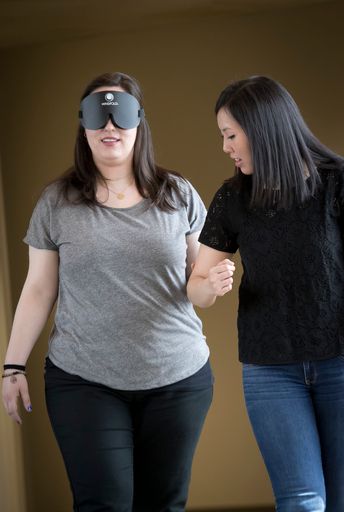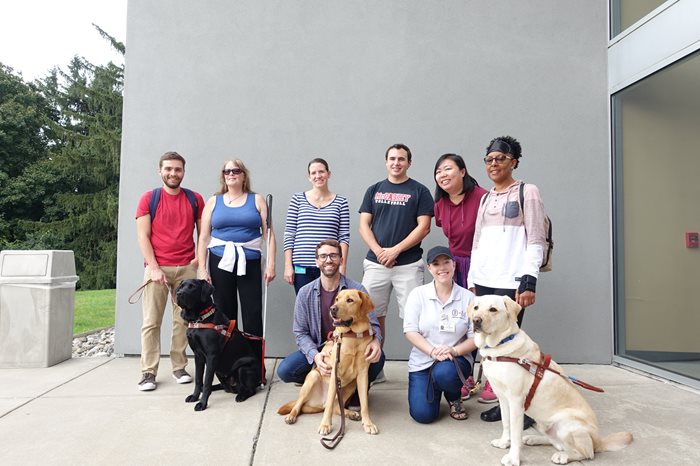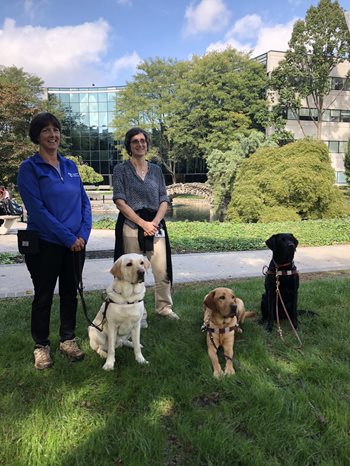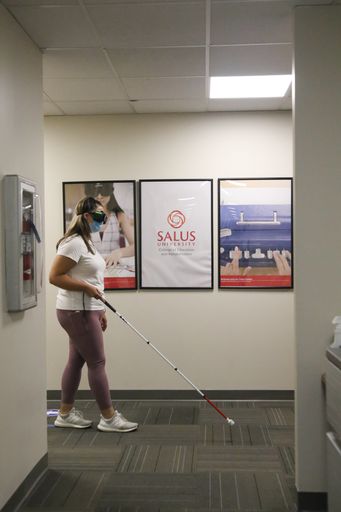We took a look at the field of Orientation & Mobility, one of our programs within the Blindness and Low Vision Studies Program. In speaking with the program's director, Jamie Maffit, she took a moment to educate us on what it means to be an O&M specialist.
I'm Jamie Maffit and I am the director of the Orientation & Mobility Program here at Salus University in the department of Blindness and Low Vision Studies. I also serve as the low-vision therapist and orientation and mobility specialist at the William Feinbloom Vision Rehabilitation Center at the Eye Institute as well.
 Q: What is orientation and mobility? Can you give us a little background on that?
Q: What is orientation and mobility? Can you give us a little background on that?
A: It seems like a simple question, but it's actually quite a complex answer. So orientation and mobility instruction is individualized instruction for individuals with visual impairments, and it's goal-specific for meeting their needs for independent travel. That can include instruction on the use of remaining senses, hearing, sense of touch, functional vision. It can include concept development, orientation skills, problem-solving skills, and then mobility skills and techniques, perhaps with a long cane or supporting the use of travel with a dog guide.
In addition, with the advances in technology, we now see more and more electronic travel aids and learning how to incorporate those into our instruction as well is part of orientation and mobility. So basically an O&M instructor can work with a student with visual impairment. It could be a child. It could be an infant. It could be an adult. It could include goals in terms of safe movement within their classroom, their home, or perhaps accessing public transportation to travel to and from work or school.
Q: Can you describe the differences between methods and skills used by blind and visually impaired individuals to orient themselves in the world, for instance, like a guide dog versus the white cane?
A: You bring up a good question about the differences in orientation and mobility. A dog guide or a long cane are used for mobility skills, so how to safely navigate around obstacles, detect drop-offs, avoid overhanging branches and such. Orientation skills are a whole other set of skills in terms of knowing where you are, knowing where you're going, and using different systems to be able to, with intention, travel to your desired destination. So in terms of orientation skills, there's a whole set of skills that can be using cardinal directions and learning how to use those efficiently. I mean how many of us use those in our daily lives?
Believe it or not, they are helpful. Or understanding address systems and learning how to navigate based on location of addresses in residential or business environments. And then you have the mobility skills and techniques and the mobility system, which would be the dog guide or the long cane.
Q: Also piggybacking on that, I think we'll go right into to what it takes to be eligible for a dog guide. Can you explain that process?
A: Typically each dog guide school, and there are many different schools across the country, they have different requirements for accepting students. Some include age. You have to be at an age where you can take on the responsibility of caring for an animal. Some include your functional vision. Some dog guide schools are more stringent about the level of vision that their students have to be paired with a dog guide, and then as well as your independent travel prior to being placed and learning how to travel with a dog guide.
 Typically a student has already gone through the orientation and mobility instruction provided by an O&M instructor and needs a sponsorship or at least their instructor needs to submit some information based on their independent travel to be eligible for a dog guide. Because as you can imagine, traveling with a service animal, there can be some things that are unexpected. Perhaps the dog is sick or the dog ages to a point where they're not able to travel. The person still needs to be able to get to where they need to go, so they will have to rely on their other travel skills, perhaps using a long cane.
Typically a student has already gone through the orientation and mobility instruction provided by an O&M instructor and needs a sponsorship or at least their instructor needs to submit some information based on their independent travel to be eligible for a dog guide. Because as you can imagine, traveling with a service animal, there can be some things that are unexpected. Perhaps the dog is sick or the dog ages to a point where they're not able to travel. The person still needs to be able to get to where they need to go, so they will have to rely on their other travel skills, perhaps using a long cane.
So to be eligible for a dog guide really does depend on the different schools' entrance requirements and acceptance requirements, but also the person's independent travel prior to being placed with a dog guide. Because a dog really is a helpful mobility system, but the person being paired with the dog guide is the person in charge of the travel. A dog isn't going to tell you when to cross the street. The person has to be able to tell them when to cross the street. A dog does have what they call intelligent disobedience.
So if the person traveling with the dog guide says it's time to cross and it's an inappropriate time, perhaps there's a quiet car there, like a hybrid car, the dog will prevent the person from crossing, which would be the intelligent disobedience that the dog guide is trained to do. But the person still needs to have their orientation skillset as well as the other techniques and strategies for travel to be able to travel with a dog guide.
Q: In what ways do COMS work with service animals?
 A: So orientation & mobility specialists, as I said before, work with the student to prepare them to have the skills necessary to travel with a dog guide. Once they're paired with a dog guide, the student may return home and need supports for travel. This typically takes the place of orientation. When they're paired with their dog guide at their respective dog guide school, they work with an instructor on how to travel safely with the dog.
A: So orientation & mobility specialists, as I said before, work with the student to prepare them to have the skills necessary to travel with a dog guide. Once they're paired with a dog guide, the student may return home and need supports for travel. This typically takes the place of orientation. When they're paired with their dog guide at their respective dog guide school, they work with an instructor on how to travel safely with the dog.
So an orientation & mobility specialist doesn't teach a student how to travel safely with a dog guide, rather once they return after learning those skills, we provide the supportive services to travel in the environment with the dog guide. Perhaps they're going to college and they need an orientation to where the cafeteria is or where their classes are for that semester. The O&M instructor will provide the orientation and route travel to the space and the person or the student will travel with the dog guide.
Q: How long have you been with Salus and also what made you want to become a COMS?
A: I started with Salus, I guess I was hired on here in 2011 and I started as a faculty member and coordinator of the program. In 2019, I don't know, a year and a half ago, I was promoted to director of the program. But I, full disclosure, went through Salus' Orientation & Mobility Program when it was the Pennsylvania College of Optometry. So I was a graduate of our program. I went and I worked in the Philadelphia area with the Bureau of Blindness and Visual Services and then was recruited to come back as a faculty member here at Salus. First of all, I never wanted to be a teacher when I was a kid. I said that's the last I wanted to do. In fact, I thought I was going to be a human rights lawyer.
Life happens. And here I ended up being a teacher. I moved to Philadelphia in 2001. I can't believe it's been that long. Or maybe 2002, I don't know. Things get blurry. I started working in adult education. I worked and coordinated a high school diploma program here in Philadelphia and I loved it. I loved everything about it except the stability in the employment, as opportunities for adults to pursue their high school diploma were not necessarily a priority within our Department of Education.
So I had looked at different options because I love teaching adults and I loved working with adults on very applicable life skills. I liked working in small groups. I did a year of AmeriCorps service after I graduated from college and I knew I did not want to work in the classroom full-time. So knowing that, having that valuable experience and then working with adults with applicable life skills here in Philadelphia, I was interested in pursuing orientation and mobility. Many folks don't know about orientation and mobility and that's one of the challenges of our field is not only to recruit professionals but also to provide services for those that need our services.
My father is totally blind so I knew about orientation and mobility. I could say my entire life I've been a guide, probably since I could walk. My father was a vocational rehab counselor and administrator, so he was very much aware of the systems for providing supports for individuals with disabilities. I think he was the one that said, "Maybe you should look at O&M." I did a search while I was in Philadelphia and, lo and behold, there was a program right outside of Philadelphia. So that's how I came to go through the program and become an orientation & mobility specialist.
I can say I'm very pleased that I did that. I love teaching O&M, whether it's to graduate students in our program or to individuals at The Eye Institute. It's a profession in that you teach something that somebody really is going to use on a daily basis to complete whatever it is that they need to do, whether that's go up and down stairs safely, cross streets safely, go grocery shopping, whatever their personal goal is.
Q: How have O&M practices been incorporated into public spaces, like accessible pedestrian signals, and how do they affect your teaching methods?
 A: As the world is our classroom, we work within whatever environment our student needs to navigate. As technology improves, we have to respond to those changes within the environment and how they're placed. So some challenges that our students encounter on a regular basis, as over time we've seen more and more volume of traffic, our students need to be able to travel and analyze intersections safely and efficiently, and among an environment that has more ambient noise than it has, say, in previous decades. As the noise level increases, it makes it harder to pick up on those quieter, more well-tuned cars for crossing streets.
A: As the world is our classroom, we work within whatever environment our student needs to navigate. As technology improves, we have to respond to those changes within the environment and how they're placed. So some challenges that our students encounter on a regular basis, as over time we've seen more and more volume of traffic, our students need to be able to travel and analyze intersections safely and efficiently, and among an environment that has more ambient noise than it has, say, in previous decades. As the noise level increases, it makes it harder to pick up on those quieter, more well-tuned cars for crossing streets.
So just if you can think about the ambient noise in an environment and then being able to localize on sounds you need to for your safe and independent travel, that can be a challenge. Our students encounter more complex intersections and here at Salus, we have one course that really delves and digs deep into how to teach these intersections for our students so they can navigate them safely. These are the intersections that you may notice you'd travel to, particularly in more suburban areas where during the day the traffic light is set to respond to the volume of traffic. So it might have a different amount of time for a green or a red light at that intersection during the day or at nighttime versus rush hour. These types of intersections are called actuated intersections.
What that means for our students is if there's no traffic on one particular leg of the street, the light may never change or it might be a shorter time allowed for them to cross the street, which has implications for safety. You may also notice there's more and more roundabouts being placed in areas, suburban areas, not necessarily rural. Well, no, they are more in rural areas too and urban areas. Those are really, from a traffic engineer's perspective, the intention is to keep traffic moving, not necessarily to provide really safe and efficient options for pedestrians to navigate.
You may see accessible pedestrian signals at intersections. When done well, these provide access to the information necessary to cross the street safely and independently regardless of your level of vision or hearing impairment. There's a type of APS system out there that someone who is deaf-blind can actually use to cross the street safely and efficiently.
Q: Can you please explain what APS is?
A: They're audible pedestrian signals. Some of the more basic ones that you may hear are the chirping at intersections. Those are not the most effective. They can be helpful, but they're not the most effective. The more advanced provide audible as well as tactual feedback to the traveler so that they know when it's time to cross the street and which street the feedback is being given for. Because that intersection with the chirping, unless you're familiarized to the intersection you might not be sure about which chirp means what at that intersection in terms of when it's time to cross.
Also with advances in GPS and smartphone technology, O&M instructors really need to be able to incorporate this to support students' travel not only for orientation purposes. I mean how many of us pull out a map anymore to get anywhere. We really just plug it into GPS. Now there is more and more accessible GPS options for students and travelers with visual impairments. Another thing that you might see are those bumps at the blended corners when you go to cross the street. I've heard various things from people about what they are for, like preventing people from slipping into the street, which I'm not sure if it would do that or not.
But the intent of those bumps, they're called truncated domes, is to provide an alert system for the person with a visual impairment to know that they're about to step into a place where they may encounter vehicles. So back when the Americans With Disabilities Act was enacted, there was some legislation regarding putting in blended curbs so travelers who use wheelchairs could safely cross streets and get back up onto the sidewalk. Well, the more blended a curb is the less likely it is for a student with a visual impairment or a traveler with a visual impairment to detect the difference between the sidewalk and the street.
An easy fix is to put in those truncated domes or those bumps that alert the traveler that they can detect with the cane in advance of walking in the street, or in the case of traveling with a dog guide, provide tactual feedback underneath their feet as well.